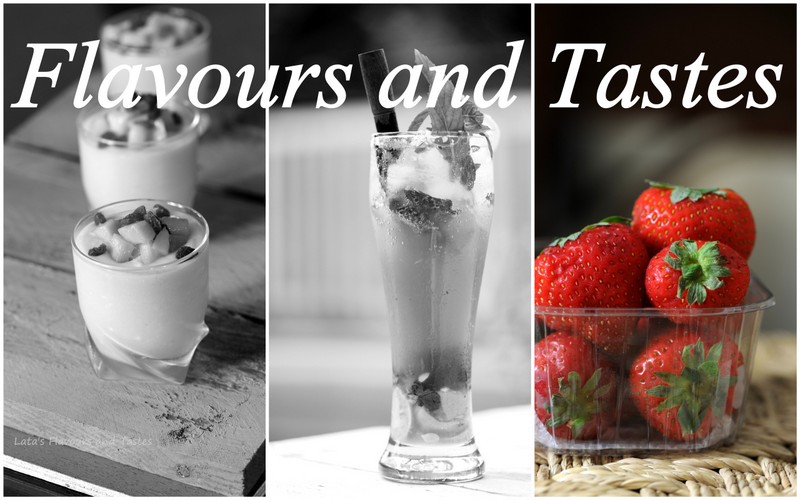It was my son-in-law's birthday few days ago. My daughter had been planning to bake his cake for him.She looked up different recipes, on the internet, in books and kept talking about that whenever we spoke to her. She wanted to be confident about baking the cake while she also wanted it to be a decorated one. I was of no help and only pointed to more blogs that sported nice looking cakes. I bake cake once in a blue moon and even those are nothing to boast about.
The one cake we are both very confident about showing as a decent one is this eggless cake with condensed milk. Then finally, she decided that she would use this recipe as her basic cake recipe, and work small alterations and bake the cake. Again, I could only, keep my fingers crossed that the cake will not fail. My fears were unwarranted; she baked it fine and did her glazing too pretty good. She was very excited with her cake that though she was aware of the time difference, she kept posting the pictures for us to see through the telephone. The next day, when we called to wish for the birthday, she promised to take pictures and send them to me with the recipe, which she told, I might want to blog. She did so promptly and I have been otherwise caught up in the festivities of Navarathri that I could not devote time to write about it. I would let it until too late, if I did not push myself to write that now.
It is her interest to try new things that is impressive. Her cooking experiments are well received and she sounds very happy that she can put good food on the table even when they have guests. I am thankful for all the blogs that she takes help from.
I am sharing here the mail that my daughter sent to me and the pictures are hers.
Eggless Chocolaty Chocolate Cake
Basic recipe can be read here:
The one cake we are both very confident about showing as a decent one is this eggless cake with condensed milk. Then finally, she decided that she would use this recipe as her basic cake recipe, and work small alterations and bake the cake. Again, I could only, keep my fingers crossed that the cake will not fail. My fears were unwarranted; she baked it fine and did her glazing too pretty good. She was very excited with her cake that though she was aware of the time difference, she kept posting the pictures for us to see through the telephone. The next day, when we called to wish for the birthday, she promised to take pictures and send them to me with the recipe, which she told, I might want to blog. She did so promptly and I have been otherwise caught up in the festivities of Navarathri that I could not devote time to write about it. I would let it until too late, if I did not push myself to write that now.
It is her interest to try new things that is impressive. Her cooking experiments are well received and she sounds very happy that she can put good food on the table even when they have guests. I am thankful for all the blogs that she takes help from.
I am sharing here the mail that my daughter sent to me and the pictures are hers.
Eggless Chocolaty Chocolate Cake
Basic recipe can be read here:
Eggless chocolate cake
Mukund’s Birthday cake baked by
Niki
Here's the cake! It's the same
recipe as our eggless cake with a few additions. I'm typing it out here, if you
want to blog it.
Makes one 9" round cake
Ingredients:
All purpose flour -
200 grams
Unsweetened
cocoa - 50 grams
Baking
powder - 1 teaspoon
Baking
soda - 1 teaspoon
Soda pop -
200 millelitres
Butter -
100 grams
Condensed
milk - 1 tin (approx. 14 oz)
Vanilla essence - 2 teaspoons
Preheat
oven to 350F/180C
Sift flour, cocoa, baking powder and baking soda - set aside
Sift flour, cocoa, baking powder and baking soda - set aside
In a big
mixing bowl, add butter, vanilla essence and condensed milk, and beat till well
mixed.
Add to
this mixture, soda pop and sifted dry mixture alternatively, beating well after
each addition.
Pour into a greased 9" round baking tin
and bake for about 45 - 50 minutes (till skewer comes out clean)
For the
glaze: (this is a Martha Stewart recipe)
4 oz of
semi dark chocolate, chopped/broken to shards) - I just used Dairy Milk Royal
Dark chocolate
3 tbsp
butter cut into small pieces
1 tbsp
whole milk
2 tsp honey (instead of the
originally given light corn syrup)
Put
chocolate and butter in a bowl and heat over a pan of simmering water, mixing
gently until it is melted.
Once
melted, add milk and honey and mix well
Use immediately, to glaze the
completely cooled cake.
Decorate with maraschino cherries.
Enjoy the extra chocolaty chocolate cake with your loved ones.

.JPG)
.JPG)


.JPG)
.JPG)
.JPG)
.JPG)
.JPG)
.JPG)
.JPG)
.JPG)
.JPG)
.JPG)
.JPG)
.JPG)
.JPG)
.JPG)
.JPG)